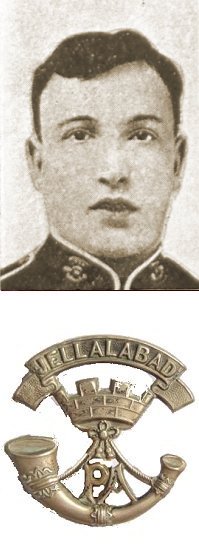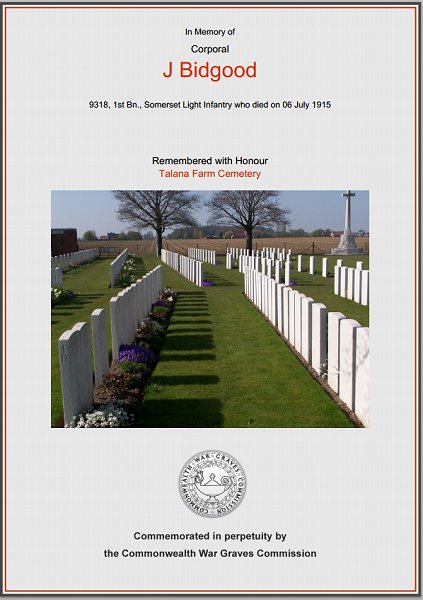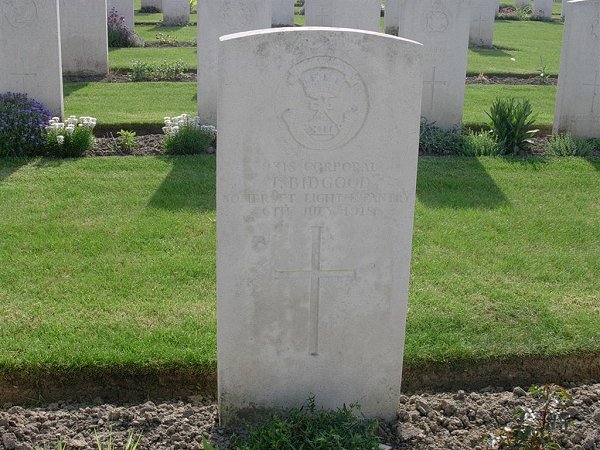yeovil at War
john james bidgood
Died in Belgium during an artillery bombardment
John James Bidgood was born in July 1895 at Bradninch, Devon. He was the eldest son of Tom and Bessie Bidgood. In the 1901 census, domestic gardener Tom and Bessie were living at Brompton Ralph, Somerset, with their eight children. John, the third eldest child, was their oldest son. In the 1911 census Tom and Bessie were living at Preston Road. By this time they had been married for 23 years and had 11 children, two of whom had died in infancy. Living with them at this time were seven of their children, of whom 17-year-old John was the eldest. Tom gave his occupation as a County Council caretaker while John gave his as a porter.
 In
July 1911 John
enlisted in the
Army at Taunton
where he became
Private John
Bidgood (Service
No 9318) of 1st
Battalion,
Somerset Light
Infantry. He
would later rise
to the rank of
Corporal.
In
July 1911 John
enlisted in the
Army at Taunton
where he became
Private John
Bidgood (Service
No 9318) of 1st
Battalion,
Somerset Light
Infantry. He
would later rise
to the rank of
Corporal.
At the outbreak of war in 1914 the 1st Battalion was in Colchester, with 11th Brigade, 4th Division. The Battalion landed at Le Havre, France with the British Expeditionary Force (BEF) on 22 August 1914, in time to fight in the battle of Le Cateau during the retreat from Mons. The 1st Battalion, Somerset Light Infantry remained on the Western Front with 4th Division, throughout the war, suffering a total of 1,315 losses.
John Bidgood saw a full year of combat, fighting in all the following battles with the 1st Battalion of the Somersets.
In 1914 the 1st Battalion saw action at the Battle of the Marne, the Battle of the Aisne and at the Battle of Messines.
The First Battle of the Marne, fought from 5 to 12 September 1914, resulted in an Allied victory against the German Army. The battle was the culmination of the German advance into France and pursuit of the Allied armies which followed the Battle of the Frontiers in August, which had reached the outskirts of Paris. The counterattack of six French field armies and the British Expeditionary Force (BEF) along the Marne River forced the German Imperial Army to abandon its push on Paris and retreat north-east, leading to the 'Race to the Sea' and setting the stage for four years of trench warfare on the Western Front. The Battle of the Marne was an immense strategic victory for the Allies, wrecking Germany's bid for a swift victory over France and forcing it into a drawn-out two-front war.
The First Battle of the Aisne was the Allied follow-up offensive against the right wing of the German First and Second Armies as they retreated after the First Battle of the Marne earlier in September 1914. The offensive began on the evening of 13 September, after a hasty pursuit of the Germans. When the Germans turned to face the pursuing Allies on 13 September, they held one of the most formidable positions on the Western Front. Low crops in the unfenced countryside offered no natural concealment to the Allies but deep, narrow paths cut into the escarpment at right angles, exposing any infiltrators to extreme hazard. In dense fog on the night of 13 September, most of the BEF crossed the Aisne on pontoons or partially demolished bridges. Under the thick cover of the foggy night, the BEF advanced up the narrow paths to the plateau. When the mist evaporated under a bright morning sun, they were mercilessly raked by fire from the flank. Those caught in the valley without the fog's protective shroud fared no better. It soon became clear that neither side could budge the other and since neither chose to retreat, the impasse hardened into stalemate that would lock the antagonists into a relatively narrow strip for the next four years.
The Battle of Messines, fought between 12 October and 2 November 1914, was part of the 'Race to the Sea', the series of battles that decided the line of the Western Front. In the aftermath of the first Battle of the Marne, it was decided to move the BEF back north to Flanders, to shorten its supply lines back to the channel ports. The Battle of Messines was the official name for the fighting between the river Douve and the Comines-Ypres canal, but it merged into the battle of Armentières to the south and the first battle of Ypres to the north.
Around this time John Bidgood was wounded and sent to a base hospital. He recovered and was sent back to the front line with his battalion. During the early part of January he distinguished himself by rescuing wounded from a mined trench under fire, for which he was recommended to the Divisional Commander by his Commanding Officer. John received a card, which he sent home, from received from Major-General HFM Wilson informing him that his officer’s recommendation had been read with much pleasure.
In 1915 the 1st Battalion, Somerset Light Infantry fought in the Second Battle of Ypres.
The Second Battle of Ypres, 22 April-25 May 1915, was a rare German offensive on the Western Front during 1915. It was launched with two aims in mind. The first was to distract attention from the movement of German troops to the eastern front in preparation for the campaign that would lead to the victory of Gorlice-Tarnow. The second was to assess the impact of poisoned gas on the western front. Gas had already been used on the eastern front, at Bolimov (3 January 1915), but the tear gas used there had frozen in the extreme cold. At Ypres the Germans used the first lethal gas of the war, chlorine. The gas was to be released from 6,000 cylinders and would rely on the wind to blow it over the allied trenches. This method of delivery controlled the timing of the attack – the prevailing winds on the western front came from the west, so the Germans had to wait for a suitable wind from the east to launch their attack. The line around Ypres was held by French, Canadian and British troops. The attack on 22 April hit the French lines worst and, not surprisingly, the line broke under the impact of this deadly new weapon. The gas created a gap 8,000 yards long in the Allied lines north of Ypres. The success of their gas had surprised the Germans who didn’t have the reserves to quickly exploit the unexpected breakthrough, allowing enough time to plug the gap with newly arrived Canadian troops. During the battle the British, French and Canadians suffered 60,000 casualties, the Germans only 35,000.
In July 1915 the 1st battalion moved down to the Ypres area to join the 3rd Army. However, having survived the major battles described above, John Bidgood was killed in action by an artillery shell during a bombardment on 6 July 1915. He was just 21 years old.
On 30 July 1915 the Western Gazette reported "Another Yeovilian to die in defence of his country’s honour is Corporal J Bidgood, of the 1st Somerset Light Infantry, who was killed by a piece of shell on the morning of July 6th last. Corporal Bidgood went to the Front in August last, and has been in practically every action in which his Regiment has been engaged up to the time of his death. He was wounded during the latter part of last year, but made an early recovery at a base Hospital, and was soon back in the firing line. At a later period, the deceased soldier was reported wounded and missing, but this happily proved incorrect. During the early part of January he distinguished himself by rescuing wounded from a mined trench under fire, for which he was recommended to the Divisional Commander by his commanding officer (an incident which was referred to in the “Western Gazette” at the time). His parents treasure as a lasting memento of their soldier son, a card which he sent home, which he had received from Major-General H.F.M. Wilson informing him that his officer’s recommendation had been read with much pleasure. Although there was no official corroboration of Corporal Bidgood’s death till within the last few days, his parents who live at 12 Ilchester Road, were made aware of that distressing fact about a fortnight ago in a letter received from Sergeant W Hansford, of the deceased’s company. In a second letter the sergeant extended the sympathy of the men of the company with the bereaved parents, and paid a high tribute to their son’s bravery. Corporal Bidgood, although he had seen so much service, had received no leave since going to the Front, but he was anticipating a short visit home this month, as the men of his Regiment were being granted a furlough. It was thought possible that he might be able to celebrate his 22nd birthday - and, incidentally, the completion of four year’s service in the Army - at home, and his death therefore, came as a great shock to his parents. General sympathy is expressed for Mr. and Mrs. Bidgood in their great loss as their son was well known in the town."
John Bidgood was interred at Talana Farm Cemetery, West-Vlaanderen, Belgium, Grave I.D.6, and his name is recorded on the War Memorial in the Borough.
gallery

The Commonwealth War Graves Commission certificate in memory of John Bidgood.

John Bidgood's headstone.